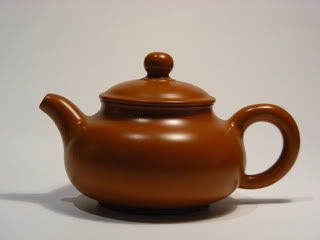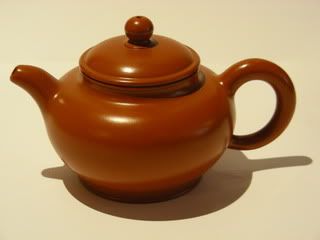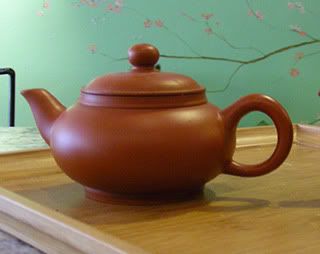Chaozhou pots are generally made with a local red clay. I think they're hard to find outside of that area because they're not as famous, though I'm sure Chaozhou pots are sold as Yixing in at least some cases.
Imen says there is also a Chaozhou "zhuni" (I assume the same characters / meaning as the Yixing zhuni, but I don't know this for sure), which is black when fired, and has nothing to do with Yixing zhuni. She sometimes carries Chaozhou pots, so you could try calling Tea Habitat if you're looking for a Chaozhou pot.
Jul 20th, '09, 21:54
Posts: 796
Joined: Sep 3rd, '08, 11:01
Location: Washington, DC
Contact:
Maitre_Tea
In Hong Kong, at the tea house next to the Tea Museum, they sell some Zhao Zhou teapots from the 80's along with some older Yixing pots. The owner of this tea shop is quite knowledgeable and probably reliable. There are some very well made pots here from ZZ. But, I haven't met anyone yet who says the clay quality can equal Yixing clay. I don't have personal experience with ZZ pots but I would never buy a new one unless I had a clay analysis.
Jul 22nd, '09, 18:29
Posts: 5151
Joined: Dec 20th, '06, 23:33
Scrolling: scrolling
Location: Gainesville, Florida
Jul 22nd, '09, 20:47
Posts: 796
Joined: Sep 3rd, '08, 11:01
Location: Washington, DC
Contact:
Maitre_Tea
Re: Chao Zhou Teapot?
Wow, that's actually not a bad price. I am a little curious about the differences between Yixing and Chao Zhou clay though.
Jul 22nd, '09, 21:26
Posts: 5151
Joined: Dec 20th, '06, 23:33
Scrolling: scrolling
Location: Gainesville, Florida
Re: Chao Zhou Teapot?
I don't know anything about the clay ... maybe she would, but they look quite pretty in the photos. I bought three of the six she had: 2 new ones and one that she has been using for four years. Paypal and she gave me free shipping.
That means she has three left, these two new ones


and one more used one (about 2 yrs) which she says has some sort of crystals in it that she isn't able to get out:

That means she has three left, these two new ones


and one more used one (about 2 yrs) which she says has some sort of crystals in it that she isn't able to get out:

Jul 23rd, '09, 02:55
Posts: 796
Joined: Sep 3rd, '08, 11:01
Location: Washington, DC
Contact:
Maitre_Tea
Re: Chao Zhou Teapot?
From Imen via email:
"The fact that it's from the same region is what matters. The trees grow in the same soil as the clay pots are made. So the pots in turn release more of the same trace minerals into the tea, magnifying the substance of the Dan Cong teas."
Makes sense, and it seems like the simplest (and maybe most logical) reason for the two go together naturally.
"The fact that it's from the same region is what matters. The trees grow in the same soil as the clay pots are made. So the pots in turn release more of the same trace minerals into the tea, magnifying the substance of the Dan Cong teas."
Makes sense, and it seems like the simplest (and maybe most logical) reason for the two go together naturally.
Jul 24th, '09, 14:25
Vendor Member
Posts: 2084
Joined: Sep 24th, '08, 18:38
Location: Boston, MA
Re:
I have been confused about what zhuni is from the beginning, and now the term seems even more confusing. A few years ago, most people call chaozhou clay "hong ni" (red clay). Even though literally "hong ni" means almost the same as "zhuni", the term "zhuni" seemed to be used exclusively on some kind of yixing clay. From what time chaozhou red clay is also called "zhuni"?yangshuoren wrote: GONGFU CHA YU CHAOZHOU ZHUNIHU

Jul 24th, '09, 16:48
Vendor Member
Posts: 1990
Joined: Apr 4th, '06, 15:07
Location: NYC
Contact:
TIM
Re: Chao Zhou Teapot?
http://2.bp.blogspot.com/_rNl5VRNLz_s/S ... G_4672.JPG
The Tea Gallery also carries some Chao Zhou Teapots. The 3 in to front, Left pic.
The Tea Gallery also carries some Chao Zhou Teapots. The 3 in to front, Left pic.
Jul 24th, '09, 21:04
Posts: 5151
Joined: Dec 20th, '06, 23:33
Scrolling: scrolling
Location: Gainesville, Florida
Re: Chao Zhou Teapot?
No one seems to have verified answer to Zhuni/Hongni, the fight happened even among great masters such as Gu JingZhou vs Han QiLou..
Truth is back then Zhuni = Hongni, or they have called Zhuni as Xiao Hongni and Hongni as Hongtu. There is no official Yixing glossary as clay itself is natural composition of lots of mixture of minerals..
Zhuni mountain called Zhauzhuang, also have lots of different composition of red clays, there is Zhuazhuang Nen Hongni, Xiao Hongni, Zhuni, Jinhuang Zhuni, Huang Shi Huang etc..and potters would mix em together for better result
But what today's calling 'Hongni' type can be found lots of areas of China, Japan, Taiwan or even Korea..and its composition for example, no different from Zini. Iron amount is no higher, shrinks no more, contains lots of minerals while Zhuni is of pure yellow-ish iron-rich powder.
So what today's calling 'Zhuni' should satisfy few conditions,
Amount of iron (over 10%)
High shrinkage (over 20% therefore, wrinkle)
Crystallization (metal sound)
These characteritics give a potter a headache and owner a pleasure, more iron content gives stronger color tone, more shrinkage gives more wrinkles (=higher rate of breakage in a kiln) and is a trait of how delicate the clay is. Crystallized clay sounds higher when tapping and glossy, but Zhuni automatically gets crystallized at low temperature because of its delicate and pure nature.
These clays were found from Zhaozhuang mountain mostly, and recently Xiao Mei Yao, Huanglong mountain, Hufu etc..
Correct me if I'm wrong..
Truth is back then Zhuni = Hongni, or they have called Zhuni as Xiao Hongni and Hongni as Hongtu. There is no official Yixing glossary as clay itself is natural composition of lots of mixture of minerals..
Zhuni mountain called Zhauzhuang, also have lots of different composition of red clays, there is Zhuazhuang Nen Hongni, Xiao Hongni, Zhuni, Jinhuang Zhuni, Huang Shi Huang etc..and potters would mix em together for better result
But what today's calling 'Hongni' type can be found lots of areas of China, Japan, Taiwan or even Korea..and its composition for example, no different from Zini. Iron amount is no higher, shrinks no more, contains lots of minerals while Zhuni is of pure yellow-ish iron-rich powder.
So what today's calling 'Zhuni' should satisfy few conditions,
Amount of iron (over 10%)
High shrinkage (over 20% therefore, wrinkle)
Crystallization (metal sound)
These characteritics give a potter a headache and owner a pleasure, more iron content gives stronger color tone, more shrinkage gives more wrinkles (=higher rate of breakage in a kiln) and is a trait of how delicate the clay is. Crystallized clay sounds higher when tapping and glossy, but Zhuni automatically gets crystallized at low temperature because of its delicate and pure nature.
These clays were found from Zhaozhuang mountain mostly, and recently Xiao Mei Yao, Huanglong mountain, Hufu etc..
Correct me if I'm wrong..
Re: Chao Zhou Teapot?

This is Hongni ore, some yellowish some greenish, a solid one

This is Zhuni ore, particle is smaller and softer than Hongni
http://farm3.static.flickr.com/2026/219 ... 3133b1.jpg
This is Huang Shi Huang, looks like egg's sunny side, very sought-after one.
Itself can't be made into teapot cos it has no plasticity, instead it's added into other clays, added one turns incredibly beautiful in color after firing.
If it's added into Zhuni clays, color gets deeper.
Jul 26th, '09, 20:56
Posts: 5151
Joined: Dec 20th, '06, 23:33
Scrolling: scrolling
Location: Gainesville, Florida
Re: Chao Zhou Teapot?
I now have 4 Chao Zhuo teapots and I am delighted with them. They tend to be thinner than their Yixing brothers. The texture, shiny, color, and feel of the outside surfaces of all of them are great though none is an expensive pot.
Imen sent some care instructions that I thought would be worth sharing:
Imen sent some care instructions that I thought would be worth sharing:
- Here is how to break in a Chao Zhou pot.
Rinse under room temp running water, scrub off the dust inside of the pot. Then sock in room temperature water for 20 minutes. You can now add off boil water to rinse. Then add teas you don't drink and make tea, soak for a few hours. Change tea and make another pot to soak over night. The pot is ready to be used. In case there is still clay smell, soak another pot of tea over night. Do not boil them like the YiXings!
For normal usage, soak the pot for 20 minutes before adding hot water. Else it can crack. (It's not always the case for every pot, but I don't think you want to take the chance.) They are very thin, so more prone to easy breaking. I cracked half a dozen pots myself, it took me that many times to figure out what to do. For speedy raising the pot, take out tea leaves and empty all the tea after brewing, let it dry naturally without rinsing. With some old bush Dan Cong brewing, you'll have a very nice pot in a couple of weeks.